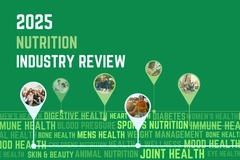
- Industry news
Industry news
- Category news
- Reports
- Key trends
- Multimedia
Multimedia
- Journal
- Events
- Suppliers
Suppliers
- Home
- Industry news
Industry news
- Category news
- Reports
- Key trends
- Multimedia
Multimedia
- Events
- Suppliers
Suppliers
American Heart Association calls for more research to refine UPF dietary guidelines

The American Heart Association’s (AHA) latest Science Advisory review concludes that although most ultra-processed foods (UPFs) have a poor nutritional quality and are linked to adverse health outcomes, this is not true for all. The experts recommend multilevel strategies, including more research to uncover how UPFs specifically impact the body and to more strongly discourage excessive consumption of nutrient-poor UPFs in dietary guidance.
Moreover, the association’s experts say research should clarify the impact of the few UPFs with more favorable nutrition profiles, and call for more investigations on the health impacts of food additives and evidence-based policies to evaluate and regulate those additives.
The Science Advisory summarizes current knowledge on UPFs and their impact on cardiometabolic health, and outlines opportunities for research, policy, and regulatory reform to improve dietary intake and overall health.
“The relationship between UPFs and health is complex and multifaceted,” says Maya Vadiveloo, Ph.D., registered dietitian, AHA fellow, and volunteer chair of the writing group for this Science Advisory.
“Eating foods with too much saturated fat, added sugars, and salt is unhealthy. We don’t know if certain ingredients or processing techniques make a food unhealthy above and beyond its poor nutritional composition. And if certain additives and processing steps used to make healthier food, like commercial whole grain breads, have any health impact.”
Rise in UPF consumption
The Science Advisory states that UPFs are relatively inexpensive, convenient, and “aggressively marketed,” specifically toward younger people and under-resourced communities where they often displace healthier alternatives. An estimated 70% of US grocery store products contain at least one ultra-processed ingredient.
Last week, the Centers for Disease Control reported new data that 55% of calories consumed by people over one year old in the US were UPFs.
Rising UPF consumption lowers the overall nutritional quality of typical eating patterns in the US. The AHA report details that many UPFs contribute to excessive calories and are often high in saturated fats, added sugars, and sodium/salt. These combinations contribute to adverse cardiometabolic health outcomes, such as heart attack, stroke, obesity, inflammation, type 2 diabetes, and vascular complications.
 Public health advocates caution that focusing solely on processing levels may mislead consumers.It also refers to observational studies that link higher UPF consumption to an increased risk of cardiovascular disease, chronic illness, and mortality. At the same time, emerging evidence suggests certain additives and industrial processing techniques may have adverse health effects.
Public health advocates caution that focusing solely on processing levels may mislead consumers.It also refers to observational studies that link higher UPF consumption to an increased risk of cardiovascular disease, chronic illness, and mortality. At the same time, emerging evidence suggests certain additives and industrial processing techniques may have adverse health effects.
Moreover, research indicates there may be underlying mechanisms that affect eating behaviors and obesity for some people, where UPFs may promote obesity as they include ingredient combinations that enhance palatability and reduce cost.
The report notes that efforts to understand UPFs are hindered by differing definitions, limitations in dietary assessment tools and food composition databases, which often lack detailed information on additives and processing methods. It uses the much-debated Nova framework to classify UPFs, but cautions that this model does not consider foods’ nutritional quality.
Research and policy changes
The latest Science Advisory highlights several research and policy changes to improve public health and reduce risks related to UPFs. These recommendations balance multiple priorities, including a nutrient-dense and affordable food supply.
”More research is needed to understand better the mechanisms of how UPFs impact health,” says Vadiveloo.
“In the meantime, the Association continues to urge people to cut back on the most harmful UPFs that are high in saturated fats, added sugars, and sodium, and excessive calories and instead follow a diet rich in vegetables, fruits, nuts, seeds and whole grains, low-fat-low-sugar dairy, and lean proteins like fish, seafood, or poultry — for better short- and long-term health.”
The report recommends introducing tailored approaches for individuals, food manufacturers, and the retail industry that help shift eating patterns away from UPFs high in saturated fat, added sugars, and sodium toward healthier dietary patterns.

AHA urges more research to understand whether additives and processing techniques make some UPFs harmful beyond their poor nutritional content.
It also calls for enacting multipronged policy and systems-change strategies, such as food labels, to help reduce the intake of foods high in saturated fat, added sugar, and sodium.
The experts urge more research funding to explore critical questions, such as to what extent a UPF’s ultra-processing makes it unhealthy or its content of unhealthy ingredients.
They stress that a better understanding of UPFs’ root causes in poor health effects is crucial for effective reduction strategies, as most UPFs are high in saturated fat, added sugar, and sodium — which cardiometabolic risk reduction already focuses on.
Moreover, the experts advise enhancing ongoing efforts to improve food additive science, including streamlined and efficient evaluation and regulation of food additives.
Healthful UPFs
The experts caution that using processing degrees as a proxy for food healthiness could sway the food industry to reduce or remove markers of ultra-processing and promote foods high in saturated fats, added sugars, and salt as “better-for-you” alternatives.
The Physicians Committee for Responsible Medicine welcomes AHA’s nuanced approach to UPFs and agrees with the report’s recommendation for more research.
“We are pleased to see the AHA point out that there are healthful and unhealthful UPFs,” says Noah Praamsma, registered dietitian nutritionist and Nutrition Education coordinator at the Physicians Committee.
 Experts warn that not all UPFs are unhealthy and note that plant-based milks, fortified cereals, and canned vegetables can support a balanced diet.“There are actually many healthful UPFs that reduce the risk of disease and tend to have one thing in common: they are derived from plants. Breakfast cereals, plant-based milks (like soy milk and oat milk), many breads, pasta, canned fruits and vegetables, and plant-based meat substitutes can belong in a healthy diet, especially if they replace animal products.”
Experts warn that not all UPFs are unhealthy and note that plant-based milks, fortified cereals, and canned vegetables can support a balanced diet.“There are actually many healthful UPFs that reduce the risk of disease and tend to have one thing in common: they are derived from plants. Breakfast cereals, plant-based milks (like soy milk and oat milk), many breads, pasta, canned fruits and vegetables, and plant-based meat substitutes can belong in a healthy diet, especially if they replace animal products.”
The public health advocacy nonprofit highlights that in plant products, processing is sometimes explicitly done for health reasons, such as adding vitamins and minerals like folate or vitamin D.
“The term ‘ultra-processed food’ is a shortcut term that misses a lot of nuance. Most importantly, it distracts the public from the problems of meat and dairy products,” Praamsma adds. “Choosing a veggie burger instead of a beef burger is healthful.”
Last month, the committee cautioned that few US consumers can identify healthy UPFs, with 39% of respondents to an online poll incorrectly saying all processed foods are unhealthy. Participants also pointed to incorrect foods as causes of type 2 diabetes risk, such as sugar (51%), desserts (19%), and carbohydrates in general (7%).
At the same time, a new clinical trial published last week indicated that people lost twice as much weight eating minimally processed foods compared to UPFs, even when foods were nutritionally matched. However, experts question the study’s conclusions, which also found that participants consumed more calories when on a UPF diet.
“It’s important that health organizations make their guidance very clear to consumers. Only a third of Americans report regularly reading food labels, so telling people to avoid UPFs high in saturated fat, sugar, sodium, and calories may not be realistic guidance,” concludes Praamsma.
“A more helpful approach would be to clearly name the culprits: Processed meat and sandwiches, frozen meals, and other foods that contain them.”











